 Most viewed Most viewed |

39 views
|
|

JR Tottori Station is on the San'in Line along the Sea of Japan coast.39 views
|
|

39 views
|
|

39 views
|
|

39 views
|
|

39 views
|
|

39 views
|
|

Came a little too early.39 views
|
|

39 views
|
|

About Sanmon Gate.39 views
|
|

39 views
|
|

39 views
|
|

39 views
|
|

39 views
|
|

39 views
|
|

39 views
|
|

39 views
|
|

39 views
|
|

39 views
|
|

View from Fushimi Castle.39 views
|
|
|
|

I asked the float's leader about the cost. I was told that they spent ¥200,000 for edible float materials and ¥800,000 for festival expenses even with free labor.39 viewsThey work on the float in the evenings after work or school. They solicit donations from neighborhood residents and sponsors.
|
|

On the first day (Sat.), the floats are paraded along the streets as they go to Himure Hachimangu Shrine and undergo judging for best design. The floats are works of art and made of edible materials mounted on a straw and wood base. Sanwakai float. 参和39 viewsMarch 17, 2018
|
|

Sanwakai float approaching the shrine. 参和会39 views
|
|

Float bearers spin around while shouting "Cho-yare" or "Masse masse!" Dai-niku float 第二区39 views
|
|

Jukku-kai float. 十区会39 views
|
|

Jukku-kai float. 十区会39 views
|
|

This one has a picture of the famous Azuchi Castle which is in Omi-Hachiman. The castle was built by warlord Oda Nobunaga in the 16th century. This festival originated in Azuchi. Jukku-kai float. 十区会39 views
|
|

Shichikukai float. 紫竹会39 views
|
|

Shinmachi-dori float. 新町通り39 views
|
|

39 views
|
|

39 views
|
|

Suwai-cho float leaving the shrine for the procession. 仲屋町39 views
|
|

In front of the torii and Hakuunkan. Uwai-cho float leaving the shrine. 魚屋町39 views
|
|

On Sat., the first day of the two-day festival, there is a procession from 2 pm. It is led by these shrine officials and the shrine priest on horseback.39 views
|
|

Shrine priest on horseback and behind him on another horse is the mayor of Omi-Hachiman who serves as the Honorary Chairman of the Sagicho Festival.39 views
|
|

Shichikukai float. 紫竹会39 views
|
|

Shichikukai float. 紫竹会 Lots of peas and beans.39 views
|
|

Shichikukai float. 紫竹会39 views
|
|

Dai-Juikku float's Tosa dog. 第十一区39 views
|
|

39 views
|
|

Float leader directing the float bearers carrying the float. Jukku-kai float. 十区会39 views
|
|

Uwai-cho float. 魚屋町39 views
|
|

39 views
|
|

Saicho, founder of Tendai Buddhist Sect, also prayed at Tarobo. Up to when Shinto and Buddhism was separated during the Meiji Period, both Shinto and Tendai followers worshipped at Tarobo.39 views"Tarobo" is the name of the Tengu goblin serving as the guardian of this shrine. The shrine god is known as the "God of Victory," for business prosperity, winning something, beating a disease, or passing an exam.
|
|

Mt. Mitsukuriyama, home of Tarobogu Shrine.39 views
|
|

39 views
|
|

39 views
|
|

39 views
|
|

39 views
|
|

39 views
|
|

Omotesando path to the main shrine. 表参道39 views
|
|

39 views
|
|

39 views
|
|

Inside Ichigansha Shrine 一願社 (一願成就社). 39 views
|
|

39 views
|
|

Thus rest house has all these old paintings and objects.39 views
|
|

39 views
|
|

Nice visit to Tarobogu.39 views
|
|

39 views
|
|

Yamanouchi Kazutoyo39 views
|
|

Gifu Yanagase shopping arcade.39 views
|
|

39 views
|
|

Taxi with Nobunaga design.39 views
|
|

Awa Odori dance troupe from Nagoya also gave a street performance.39 views
|
|

39 views
|
|

39 views
|
|

It is also has a consultation center for South American residents of Kobe. Operated by the city of Kobe, the current facility opened on June 3, 2009.39 views15-min. walk from JR Motomachi Station (East Exit) on the JR Tokaido/Kobe Line. Walk straight along Koikawa-suji road (鯉川筋). Or 10-min. walk from Kencho-mae Station on the subway line. From JR Shin-Kobe Station (shinkansen), 10-min. taxi ride.
|
|
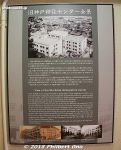
Old Kobe Immigration Center.39 views
|
|
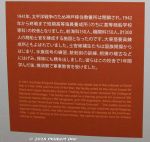
History of the emigrant center: 1940s39 views
|
|
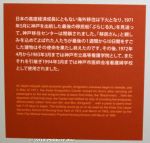
History of the emigrant center: 1970s-80s as a School of Nursing.39 views
|
|

Pictures of emigrants.39 views
|
|
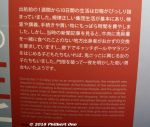
Life in the emigration center.39 views
|
|

This is how the sleeping quarters looked like at the Kobe emigration center.39 views
|
|

Electronical appliances.39 views
|
|

Corridor on an upper floor.39 views
|
|

3rd floor39 views
|
|

Kobe Port Tower ticket window. 39 views
|
|

Emigration monument at Meriken Park.39 views
|
|

Kobe Port39 views
|
|

39 views
|
|

Restaurant includes this Kobe Port Tower rice.39 views
|
|

About Meriken Pier.39 views
|
|

The pier that damaged by the Great Hanshin earthquake in 1995 has been retained as is.39 views
|
|

The pier that damaged by the Great Hanshin earthquake in 1995 has been retained as is.39 views
|
|

39 views
|
|

39 views
|
|

39 views
|
|

39 views
|
|

39 views
|
|

39 views
|
|

39 views
|
|

39 views
|
|

39 views
|
|

39 views
|
|

39 views
|
|

39 views
|
|

39 views
|
|

39 views
|
|

39 views
|
|

39 views
|
|

39 views
|
|

39 views
|
|

39 views
|
|

39 views
|
|

Some float pullers had distinctive hairstyles.39 views
|
|

39 views
|
|

39 views
|
|

39 views
|
|

39 views
|
|

39 views
|
|

39 views
|
|

39 views
|
|

39 views
|
|

39 views
|
|

39 views
|
|

No cigarette lighters, just a bunsen burner to quickly light the candles in the lanterns.39 views
|
|

39 views
|
|

39 views
|
|

39 views
|
|

39 views
|
|

39 views
|
|

39 views
|
|

39 views
|
|

View from Tsutenkyo Bridge. That bridge in the distance is where you enter the temple.39 views
|
|

Kiyotaki Tokugen-in Temple's garden in autumn.39 views
|
|

Kiyotaki Tokugen-in Temple's garden in autumn.39 views
|
|

On the left is the Hondo. The building on the right is the entrance. Pay the small admission and see the inner garden on weekends and spring/fall season.39 views
|
|

View of Tokugen-in Temple's garden in autumn.39 views
|
|

39 views
|
|
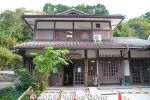
Kurotani village has this Kurotani Washi Kaikan gift shop (黒谷和紙会館). Kurotani is not touristy because it's not convenient to get here.39 views
|
|
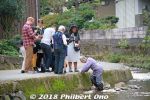
While soaking, the kozo bark is also kneaded by human feet to soften it. The water is cold, and it's a traditional job for the grandmas.39 views
|
|
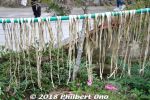
The brown kozo bark is shaved and scraped with a knife by hand to remove the brown bark skin and other blemishes. Then the becomes thin, white strips that are dried in the sun. (shiro-kawa 白皮)39 views
|
|
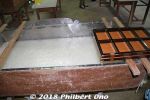
A large vat (sukifune) filled with washi fibers floating evenly in the water. The fibers are mixed in with a plant-based adhesive so they don't sink to the bottom and they also cling together to make the paper. 39 viewsA wooden mold (keta 桁) to make eight postcards on the right. Kurotani washi bills itself as Japan's strongest paper. In the 1920s, Kurotani washi was tested for strength and was declared the strongest washi in Japan. I was told Kurotani's kozo has longer fibers than other species so the paper is stronger.
|
|

About sugeta.39 views
|
|
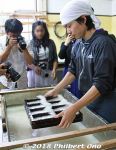
Dump the postcard mold into the vat and swish it left/right and forward/back evenly.39 views
|
|

The postcards looked quite thick out of the mold, but they would get much thinner when dried.39 views
|
|
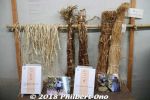
This shows how they typically hang and dry the white strips and bark strips.39 views
|
|
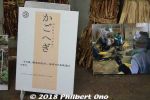
39 views
|
|
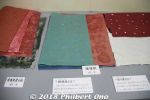
39 views
|
|
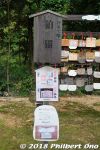
"Koma-neko Unique in Japan"39 views
|
|
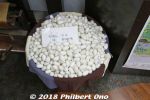
This is 3,000 silk cocoons. That's how much silk is needed to make silk fabric for one kimono. One cocoon has 1200–1500 meters of silk thread. 39 viewsSince Japan produces very little silk, most are imported from China and Brazil. The Tango region consumes about one-third of Japan's raw silk imports. We were told the quality of silk from China and Brazil is very good.
|
|
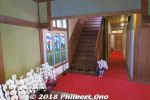
Shoeikan entrance hall.39 views
|
|
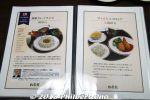
The restaurant's menu is quite cheap, prices ranging from ¥900 for Navy curry rice to ¥4,500 for a full course.39 views
|
|
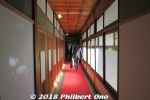
We could also go upstairs and tour the private dining rooms.39 views
|
|
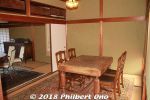
Private dining room.39 views
|
|
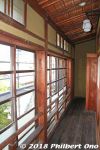
39 views
|
|
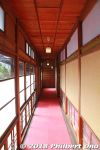
39 views
|
|
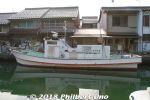
39 views
|
|
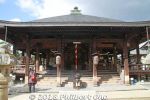
Chionji's main temple hall named the Monjudo. 文殊堂39 views
|
|
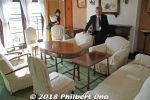
Western-style (Spanish) 2nd floor living room.39 views
|
|
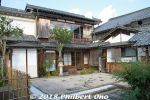
39 views
|
|
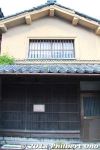
Many of the Chirimen Kaido homes have explanatory signs, but you cannot enter them since they are private homes.39 views
|
|

Roof above Cassa Armonica.39 views
|
|

Kobe Luminarie's Cassa Armonica (カッサ・アルモニカ). People lined up for the Cassa Armonica like a shrine.39 views
|
|

Inside Eirakukan. You can freely tour inside the theater. Very impressive and rare glimpse of a Meiji Period theater. 39 viewsThat's the hanamichi on the left. You can walk on it too.
|
|

Very retro.39 views
|
|

View from the stage.39 views
|
|

39 views
|
|

39 views
|
|

Go downstairs to the basement too.39 views
|
|

Way to Izushi Castle and Shinkoro Clock Tower.39 views
|
|

39 views
|
|

Entrance to the path of torii gates to Ariko-yama Inari Jinja Shrine atop Izushi Castle's main foundation. 有子山稲荷神社39 views
|
|

Ferns and trees make the place solemn.39 views
|
|

Japanese pine tree.39 views
|
|

39 views
|
|

Going back down through the torii gates.39 views
|
|

Gift shop in Izushi.39 views
|
|
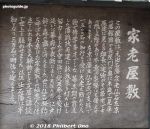
About the Samurai residence.39 views
|
|

Kinosaki Onsen's main highlight are its seven public hot spring baths (sotoyu 外湯). Some of them look palatial, and they are all distinctly different, the baths, decor, etc.39 viewsKinosaki Onsen has a long history of 1,300 years. A favorite hot spring for centuries.
|
|

Sato-no-Yu Onsen さとの湯39 views
|
|

39 views
|
|

Jizo statue at Jizo-yu public bath.39 views
|
|

39 views
|
|

The traditional building is Yanagi-yu. 柳湯39 views
|
|

It says "Kinosaki Onsen well matches people in yukata."39 views
|
|

About Yanagi-yu public bath. 柳湯39 views
|
|

The building is right next to a rock wall.39 views
|
|

Main drag outside Ichinoyu.39 views
|
|

Gosho-no-yu (御所の湯). It means "Imperial Palace Hot Spring." Open 7:00 am–11:00 pm, closed on the first and third Thursdays of the month.39 views
|
|

On a side street, the Mandala-yu (Mandara-yu) public bath. Open 3:00 pm–11:00 pm, closed Wed. Has close connection with the priest Dochi (道智上人) considered to be the founder of Kinosaki Onsen in the 8th century.39 views
|
|

Jizo and Kannon statues along a rock wall.39 views
|
|

About the Benzaiten shrine.39 views
|
|

Gokurakuji Temple's Sanmon Gate. 山門39 views
|
|

Niomon Gate to Onsenji's Yakushido Hall. 仁王門39 views
|
|

You can soft-boil your onsen eggs yourself in hot spring water. Boil the eggs for 11 min.39 views
|
|

After 11 min., the eggs were perfectly soft boiled. A niftly tool cut away the top portion of the egg shell. Sprinkle some salt and yummy!39 views
|
|

Kinosaki Onsen Ropeway goes up to Mt. Daishi.39 views
|
|

Welcome to Kinosaki Onsen Ropeway.39 views
|
|

On the summit of Mt. Daishi is this ropeway station with a cafe inside and lookout deck on the roof.39 views
|
|

View of Kinosaki Onsen from the lookout deck.39 views
|
|

Ring of wisdom. Throw clay dishes to the target. かわらけ投げ39 views
|
|

They charge a small admission for a guided tour to see the Kannon statue in the Hondo main hall's altar.39 views
|
|

About Onsenji Temple.39 views
|
|

Onsenji Temple's Tahoto pagoda39 views
|
|

First floor of Onsenji Temple's Tahoto pagoda.39 views
|
|

Kou-no-Yu's outdoor bath in a garden-like setting. 鴻の湯39 views
|
|

39 views
|
|

Otani River and willow trees.39 views
|
|

39 views
|
|

Crowd going to Hongu No. 1. You supposed to pray at Hongu No. 1 first, then you can pray at the other Hongu and secondary shrines. 39 views
|
|

Hongu No. 2 shrine fence.39 views
|
|

Hongu No. 3 shrine in front of the altar protected by netting.39 views
|
|

Inside Nankun-sha cat shrine (楠珺社). 39 views
|
|

Cat rice paddles.39 views
|
|

Grand tree at Sumiyoshi Taisha, Osaka.39 views
|
|

Free serving of hot ginger tea. That was good. Clears your nasal passages.39 views
|
|

Hankai Line tram at Sumiyoshi Torii-mae stop in front of Sumiyoshi Taisha. 阪堺線 住吉鳥居前停留場39 views
|
|

The old and now -closed Sumiyoshi Koen Station for the tram.39 views
|
|

Sumiyoshi Taisha Station on the Nankai Line.39 views
|
|
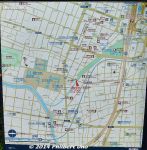
Map of Kano-juku in English. Gifu Station is on the upper right, and Kano Castle is on the left.39 viewsIt had the Honjin, Waki-Honjin, and 35 lodges. The population was 2,728.
|
|
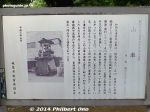
Kano used to have nine festival floats, but all except one was destroyed by World War II bombing of Gifu in 1945. The shrine buildings were also destroyed.39 views
|
|
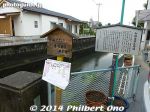
Spot where the Kosatsu bulletin board was in Kano-juku. It was originally on a stone foundation. This spot used to have many people passing by as it was near the castle's front gate. 加納宿 高札39 views
|
|
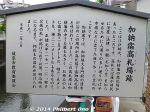
About the Kosatsu bulletin board in Kano-juku. It posted local laws and regulations and other official notices from the local ruler. 高札39 views
|
|
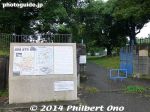
Another entrance to Kano Castle. Thanks to my friend Satomi for driving me around Kano.39 views
|
|

Arigatee's current caretaker is Ishiwata Norio and his wife Chifumi (石渡のりお・ちふみ). They moved here from Tokyo. He uses it as a artist studio. That's his painting on the wall.39 viewsKita-Ibaraki is promoting itself as an art city, and Arigatee is part of the project. Ishiwata-san and his wife were very gracious and a real boon to the city's artist community.
|
|

Monkfish/goosefish (あんこう), a type of anglerfish. They are most prized for their liver (ankimo), a local delicacy.39 views
|
|
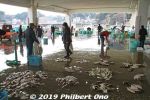
Besides monkfish, other fishes are sold at auction. This is not yet a tourist attraction since we were the only outsiders there.39 views
|
|
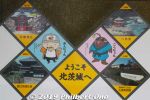
JR Isohara Station welcome sign.39 views
|
|
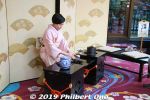
We arrived in the late afternoon in time for a tea ceremony in the hotel lobby. Conducted by the hotel's okami-san (proprietress 女将).39 views
|
|
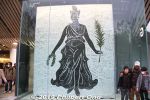
Another fresco mosaic wall mural by Hasegawa Roka. The Greek Goddess of Victory, depicting "Honor." 39 viewsThis was preserved and moved here from the old National Stadium. 「勝利の女神」
|
|
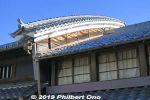
Mino in Gifu has a traditional townscape of "udatsu" homes. Udatsu is a decorative firewall on the side of the home's roof. Townscape is a rectangular area of residential streets lined with traditional homes. A few are open to the public.39 viewsNear Minoshi Station on the Nagaragawa Railway. This area is a National Important Traditional Townscape Preservation District (重要伝統的建造物群保存地区).
|
|
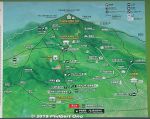
Mt. Oyama has roads, hiking paths, and a cable car going up the mountain. The main road (accessible by bus) goes up through a valley on the mountain until it reaches near the cable car station.39 viewsMost people only go halfway (elevation 700 meters) up the mountain to Oyama Afuri Shrine's Shimosha (Lower Shrine). People wanting a more challenging trek can hike to the summit to visit the Honsha main shrine. Mt. Oyama is 1,252-meters high (4,108 ft) and part of the Tanzawa Mountains.
|
|

Saiku Heian-no-mori Park recreates one of the many rectangular blocks of the Saiku Palace area. This one reconstructs three buildings used by the head of the Saikuryo, the government office of the Saiku Palace. 39 viewsThe left building is the Nishiwakiden, center is Seiden (main building), and right building is the Higashiwakiden. The buildings are only approximations of what they actually looked like. Only the size could be determined from pillar holes, but not the actual apperance. This is where the Saio Matsuri festival's Departure Ceremony is held.
|
|
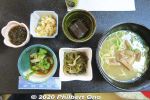
Ishigaki cuisine for lunch. Main dish was soba noodles. Side dishes of pig's ear, goya & tuna, juushi flavored rice (じゅーしー), local seaweed, and brown sugar jelly (dessert). 39 viewsPig's ear is chewy/crunchy, not really tasty, but has a lot of collagen, so it's a health food.
|
|

Walking on the tarmac to the JTA plane at Ishigaki Airport.39 views
|
|
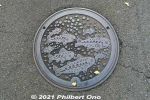
Gujo-Hachiman manhole has ayu sweetfish design.39 views
|
|
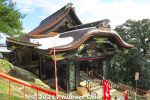
The roof was also rethatched with new cypress bark. The last time the building was reroofed was in 1972. (The white patch is snow.)39 views
|
|
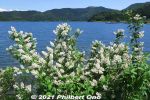
In May, these white flowers. 39 views
|
|
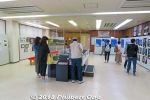
Lake Yogo Tourist Center exhibition space. 39 views
|
|

38 views
|
|

Prizes. 抽選会の景品38 views
|
|

Singing "Biwako Shuko no Uta" in a large circle.38 views
|
|

Singing "Biwako Shuko no Uta" 琵琶湖周航の歌38 views
|
|

Banzai38 views
|
|
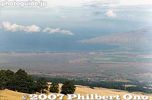
View from Haleakala, looking at Kihei.38 views
|
|

Lahaina38 views
|
|

Even before the spring flowers bloom, they find ways to color the streams.38 views
|
|

Nenshoji temple 念称寺38 views
|
|

38 views
|
|

A few steps up a slope.38 views
|
|

From Rengeji temple, a short distance away on the Nakasendo Road is this path to Naotaka Shrine.38 views
|
|

The dance parade was held along the Santsu Nakamurabashi shopping street that intersects with Nakamurabashi Station. Nakamurabashi is a short train ride from Ikebukuro Station on the Seibu Ikebukuro Line.38 views
|
|

38 views
|
|

Shinobu-ren (Koenji) teamed up with Chirudo-ren (Child-ren). しのぶ(忍)連38 views
|
|

Fukagawa Chikara-mochi38 views
|
|

38 views
|
|

38 views
|
|

38 views
|
|

Otabisho38 views
|
|

Children doing sanyare dance at Kawakami Matsuri.38 views
|
|
| 71446 files on 284 page(s) |
 |
 |
228 |  |
 |
|